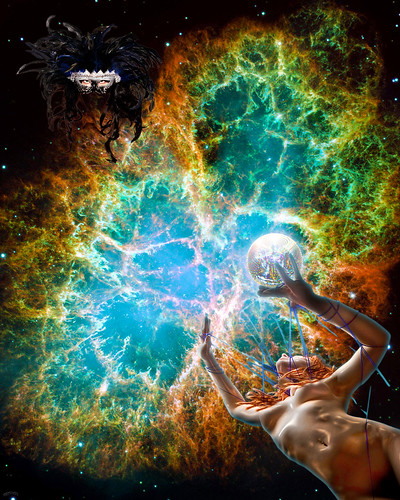Stephen Hawking: 'There are no black holes'
Notion of an 'event horizon', from
which nothing can escape, is incompatible with quantum theory, physicist
claims.
by Zeeya
Merali
The
defining characteristic of a black hole may have to give, if the two pillars of
modern physics — general relativity and quantum theory — are both correct.
“There is no escape from
a black hole in classical theory, but quantum theory enables energy and
information to escape.”
In its stead, Hawking’s radical proposal is a much more benign “apparent horizon”, which only temporarily holds matter and energy prisoner before eventually releasing them, albeit in a more garbled form.
“There is no escape from a black hole in classical theory,” Hawking told Nature. Quantum theory, however, “enables energy and information to escape from a black hole”. A full explanation of the process, the physicist admits, would require a theory that successfully merges gravity with the other fundamental forces of nature. But that is a goal that has eluded physicists for nearly a century. “The correct treatment,” Hawking says, “remains a mystery.”
Hawking posted his paper on the arXiv preprint server on 22 January1. He titled it, whimsically, 'Information preservation and weather forecasting for black holes', and it has yet to pass peer review. The paper was based on a talk he gave via Skype at a meeting at the Kavli Institute for Theoretical Physics in Santa Barbara, California, in August 2013 (watch video of the talk).
Fire fighting
In a thought experiment, the researchers asked what would happen to an astronaut unlucky enough to fall into a black hole. Event horizons are mathematically simple consequences of Einstein's general theory of relativity that were first pointed out by the German astronomer Karl Schwarzschild in a letter he wrote to Einstein in late 1915, less than a month after the publication of the theory. In that picture, physicists had long assumed, the astronaut would happily pass through the event horizon, unaware of his or her impending doom, before gradually being pulled inwards — stretched out along the way, like spaghetti — and eventually crushed at the 'singularity', the black hole’s hypothetical infinitely dense core.
This was alarming because, although the firewall obeyed quantum rules, it flouted Einstein’s general theory of relativity. According to that theory, someone in free fall should perceive the laws of physics as being identical everywhere in the Universe — whether they are falling into a black hole or floating in empty intergalactic space. As far as Einstein is concerned, the event horizon should be an unremarkable place.
Beyond the horizon
In place of the event horizon, Hawking invokes an “apparent horizon”, a surface along which light rays attempting to rush away from the black hole’s core will be suspended. In general relativity, for an unchanging black hole, these two horizons are identical, because light trying to escape from inside a black hole can reach only as far as the event horizon and will be held there, as though stuck on a treadmill. However, the two horizons can, in principle, be distinguished. If more matter gets swallowed by the black hole, its event horizon will swell and grow larger than the apparent horizon.
Conversely, in the 1970s, Hawking also showed that black holes can slowly shrink, spewing out 'Hawking radiation'. In that case, the event horizon would, in theory, become smaller than the apparent horizon. Hawking’s new suggestion is that the apparent horizon is the real boundary. “The absence of event horizons means that there are no black holes — in the sense of regimes from which light can't escape to infinity,” Hawking writes.
“The picture Hawking gives sounds reasonable,” says Don Page, a physicist and expert on black holes at the University of Alberta in Edmonton, Canada, who collaborated with Hawking in the 1970s. “You could say that it is radical to propose there’s no event horizon. But these are highly quantum conditions, and there’s ambiguity about what space-time even is, let alone whether there is a definite region that can be marked as an event horizon.”
Although Page accepts Hawking’s proposal that a black hole could exist without an event horizon, he questions whether that alone is enough to get past the firewall paradox. The presence of even an ephemeral apparent horizon, he cautions, could well cause the same problems as does an event horizon.
Unlike the event horizon, the apparent horizon can eventually dissolve. Page notes that Hawking is opening the door to a scenario so extreme “that anything in principle can get out of a black hole”. Although Hawking does not specify in his paper exactly how an apparent horizon would disappear, Page speculates that when it has shrunk to a certain size, at which the effects of both quantum mechanics and gravity combine, it is plausible that it could vanish. At that point, whatever was once trapped within the black hole would be released (although not in good shape).

If Hawking is correct, there could even be no singularity at the core of the black hole. Instead, matter would be only temporarily held behind the apparent horizon, which would gradually move inward owing to the pull of the black hole, but would never quite crunch down to the centre. Information about this matter would not destroyed, but would be highly scrambled so that, as it is released through Hawking radiation, it would be in a vastly different form, making it almost impossible to work out what the swallowed objects once were.
“It would be worse than trying to reconstruct a book that you burned from its ashes,” says Page. In his paper, Hawking compares it to trying to forecast the weather ahead of time: in theory it is possible, but in practice it is too difficult to do with much accuracy.
Polchinski, however, is sceptical that black holes without an event horizon could exist in nature. The kind of violent fluctuations needed to erase it are too rare in the Universe, he says. “In Einstein’s gravity, the black-hole horizon is not so different from any other part of space,” says Polchinski. “We never see space-time fluctuate in our own neighbourhood: it is just too rare on large scales.”
Raphael Bousso, a theoretical physicist at the University of California, Berkeley, and a former student of Hawking's, says that this latest contribution highlights how “abhorrent” physicists find the potential existence of firewalls. However, he is also cautious about Hawking’s solution. “The idea that there are no points from which you cannot escape a black hole is in some ways an even more radical and problematic suggestion than the existence of firewalls,” he says. "But the fact that we’re still discussing such questions 40 years after Hawking’s first papers on black holes and information is testament to their enormous significance."
Nature
doi:10.1038/nature.2014.14583
From Nature @ http://www.nature.com/news/stephen-hawking-there-are-no-black-holes-1.14583
See Infinite Cosmos of Light and Life: Black Holes Don’t Exist @ http://nexusilluminati.blogspot.com.au/2013/03/infinite-cosmos-of-light-and-life-dark.html
For more information about absence of black holes see http://nexusilluminati.blogspot.com/search/label/no%20black%20holes
- See ‘Older Posts’ at the end of each section
Hope you like this
not for profit site -
It takes hours of work every day
to maintain, write, edit, research, illustrate and publish this website from a
tiny cabin in a remote forest
Like what we do? Please give enough
for a meal or drink if you can -
Donate any amount and receive at least one New Illuminati eBook!
Please click below -
Images by R. Ayana @ http://farm8.staticflickr.com/7457/8732051100_3d3b1951ac_k.jpg
http://farm9.staticflickr.com/8480/8196107204_6068b68386_k.jpg
Videos - http://www.youtube.com/watch?v=KR3Msi1YeXQ
http://www.youtube.com/watch?v=Dz2A4qXJQjc
http://farm9.staticflickr.com/8480/8196107204_6068b68386_k.jpg
Videos - http://www.youtube.com/watch?v=KR3Msi1YeXQ
http://www.youtube.com/watch?v=Dz2A4qXJQjc
For further enlightening
information enter a word or phrase into the random synchronistic search box @ http://nexusilluminati.blogspot.com
And see
New Illuminati – http://nexusilluminati.blogspot.com
New Illuminati on Facebook - https://www.facebook.com/the.new.illuminati
New Illuminati Youtube Channel - http://www.youtube.com/user/newilluminati/feed
New Illuminati on Google+ @ https://plus.google.com/115562482213600937809/posts
New Illuminati on Twitter @ www.twitter.com/new_illuminati
The Her(m)etic Hermit - http://hermetic.blog.com
The Prince of Centraxis - http://centraxis.blogspot.com (Be Aware! This link leads to implicate &
xplicit concepts & images!)
DISGRUNTLED SITE ADMINS PLEASE NOTE –
We provide a live link to your original material on your site (and
links via social networking services) - which raises your ranking on search
engines and helps spread your info further! This site is
published under Creative Commons Fair Use Copyright (unless an individual
article or other item is declared otherwise by the copyright holder) –
reproduction for non-profit use is permitted & encouraged, if you
give attribution to the work & author - and please include a (preferably
active) link to the original (along with this or a similar notice).
Feel free to make non-commercial hard (printed) or software copies or
mirror sites - you never know how long something will stay glued to the web –
but remember attribution! If you like what you see, please send a donation (no
amount is too small or too large) or leave a comment – and thanks for reading
this far…
Live long and prosper! Together we can create the best of all possible
worlds…
From the New
Illuminati – http://nexusilluminati.blogspot.com

No comments:
Post a Comment
Add your perspective to the conscious collective